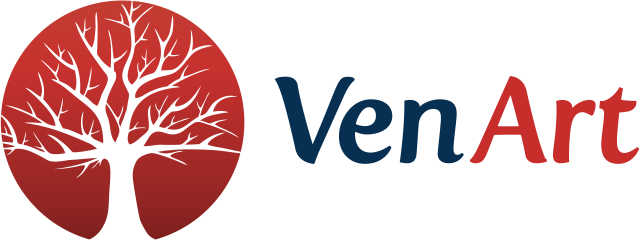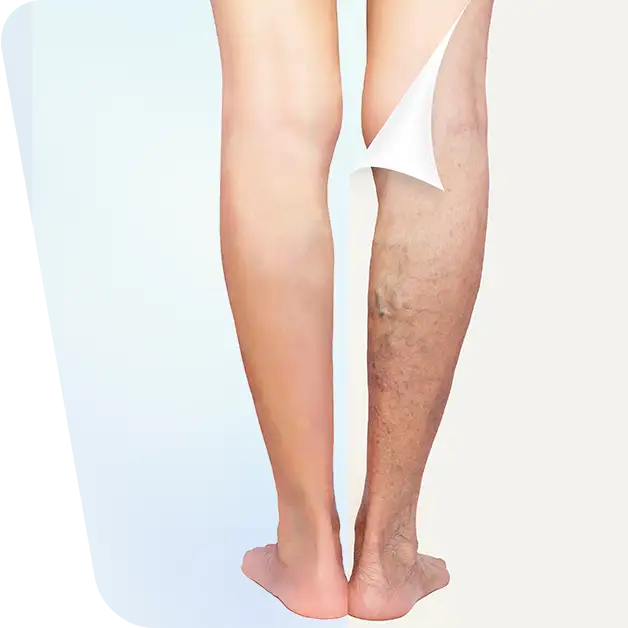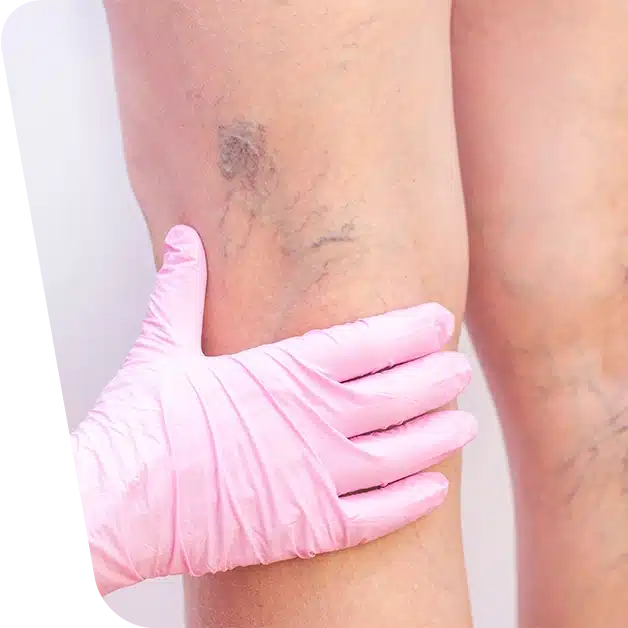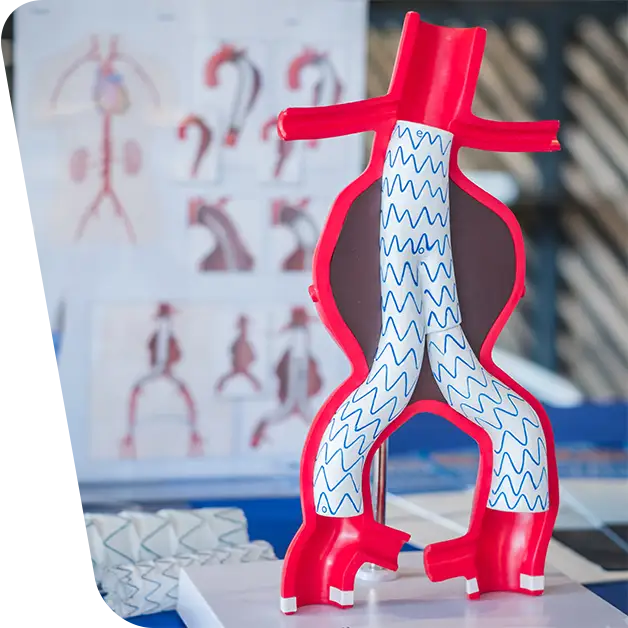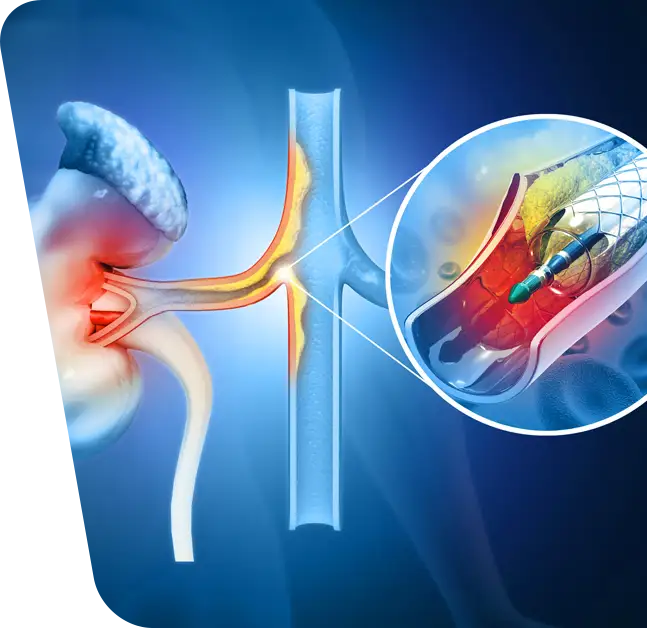The treatment of varicose veins by the Venosteam method is done on an outpatient basis using a minimally-invasive technique developed by Dr. Rene Milleret and used successfully for over 15 years in Europe. Dr. Milleret is an innovator in the field of vascular surgery, with several modern, minimally invasive methods of treating varicose veins. VenArt Clinic is the only clinic in Romania where the Venosteam method is used, with very good long-term results and multiple advantages over the classic method of treating varicose veins. Varicose vein disease affects almost one third of the population and in general the great saphenous vein or the small saphenous vein is affected in 30 to 50% of cases. Although the risk of varicose veins increases with age, 15% of the population under 40 is affected by this condition. Varicose veins, i.e. varicose vein disease, is the most common vein disease and is characterized by segmental dilations on larger venous trunks or with a reticular appearance in the case of smaller veins. Pregnancy and prolonged orthostatism (standing) favor the appearance of varicose veins and aggravate them when they are already present. Varicose veins are sometimes accompanied by muscle cramps in the lower limbs, a feeling of heavy legs, tingling, and leg oedema.
Table of contents
ToggleWhat exactly does the Venosteam technique mean?
Returning to the treatment of varicose veins by the Venosteam method, this technique is performed under ultrasound guidance and takes between 30-50 minutes. After the procedure the patient remains in the clinic under post-operative supervision for 2-3 hours and then goes home. On the day of the operation, total bed rest is recommended and on the second day the patient can resume his daily activities. The Venosteam steam method has remarkable advantages compared to other thermal methods of treating varicose veins such as laser or radiofrequency, methods which together with Venosteam are successfully used for outpatient treatment of varicose veins.
Treatment of varicose veins with the Venosteam method – Advantages
- Minimally invasive method: Varicose veins are obliterated (closed) using a small amount of steam introduced into the affected vein through a very flexible catheter whose diameter is 1.2 mm;
- No scarring: This procedure (Venosteam) leaves no scars, in addition post-operative hematomas are much reduced compared to those that occur after the classic varicose vein stripping procedure. In some cases, there is a small incision that can be seen after the operation at the catheter entry site through the skin, which disappears in 2-3 months.
Resumption of activity on the same day: Patients treated with this method can resume their activities within 24 hours. - Minimal pain: Both during the operation and in the days following the operation the pain is either non-existent or minimal, felt only as a kind of embarrassment and not as pain. Patients are often surprised by the minimal postoperative discomfort.
- Safety: Compared to the two other thermal methods used in Europe for outpatient treatment of varicose veins, namely laser and radiofrequency (VNUS), the threshold of overheating with the steam method is very high as the heat transfer process is very fast. In comparison, with the VNUS (radiofrequency) method a 7 cm portion of a vein is heated in 20 seconds while with the steam method (VenoSteam™) this is achieved in less than 1 second.
- Versatility: the Venosteam steam method can treat virtually any type of varicose vein as the type of catheter used is flexible and can be guided along tortuous veins. Treatment of collateral varicose veins and truncal varicose veins can be done in the same treatment session unlike the laser and VNUS (radiofrequency) thermal methods which are mainly used for obliteration (closure) of the large saphenous vein. Treatment of large varicose veins, recurrent varicose veins and perforating veins is not easy to achieve using these two methods (laser and radiofrequency).
Dr. Rene Milleret on the treatment of varicose veins with the Venosteam method VIDEO
VenoSteam – Equipment used
The technology used to treat varicose veins with steam has also progressed, improving with the introduction of a new VBox machine and adding functionality. The same engineers and doctors who developed both the method and the Venosteam device have also contributed to the development of the VBox device. The most important advantage is the quality of the catheter and a very fine control of evenly distributed energy.
Vein disorders
Varicose veins – Venectasia or Telangiectasia
Venectasia or spider veins are superficial veins like varicose veins but much smaller. They lie close to the surface of the skin and may be red or blue in color. They can look like the branches of a tree or like a spider’s web, formed by short non-linear lines. They can form on the legs, even on the face, and can form on small or large areas. Spider veins can be caused by several factors including blood reflux, hormonal changes, sun exposure, bumps, old age and pregnancy. In some countries of the world the percentage of affected people is as high as 55% in women and 45% in men. Often these veins can be treated by injecting a sclerosing substance that causes the vein to close (obliterate) by swelling the vein walls. This procedure is called micro-sclerotherapy using extremely fine needles.
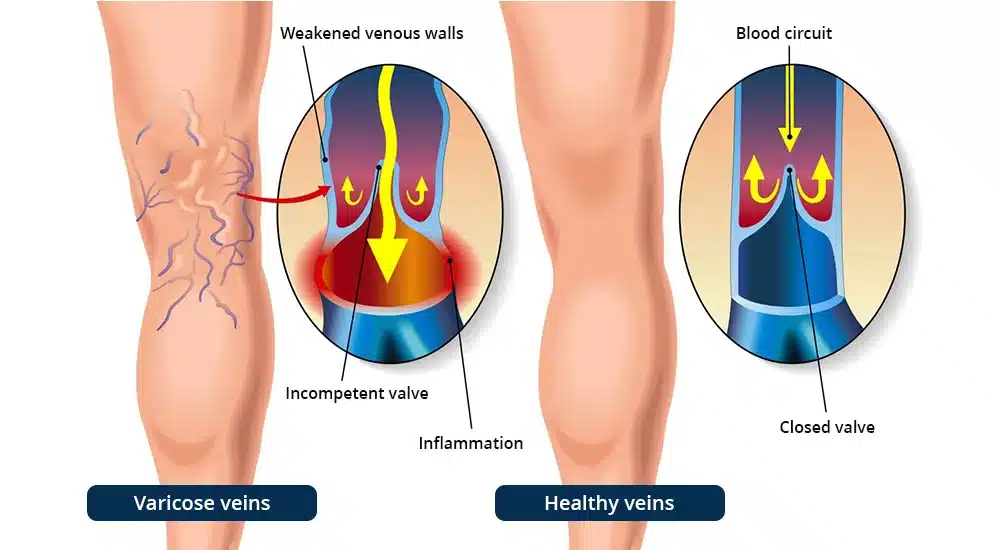
Varicose veins
Varicose disease (varicose veins) is the most common disease of the veins and is characterized by dilations on certain segments of the larger venous trunks or a reticular appearance in smaller veins. Pregnancy and prolonged orthostatism (prolonged standing) favour the appearance of varicose veins or aggravate them where they are already present. Hormonal changes can also influence or contribute to varicose veins. Secondary varicose veins occur after obstructions in the venous return pathway frequently seen after thrombophlebitis (post-thrombotic syndrome). Varicose veins are sometimes accompanied by cramping in the lower limbs, heaviness in the calves (feeling of heavy legs), tingling, leg oedema.
Thrombophlebitis
Thrombophlebitis is characterized by the formation of a blood clot (thrombosis) accompanied by inflammatory reactions of the vein wall (phlebitis).
- Superficial thrombophlebitis, in which inflammatory reactions of the superficial veins (skin redness) dominate and less embolism-generating; they are common in varicose veins, some forms of arteritis (Bürger’s disease), in endophlebitis with medication. Thrombi in superficial veins rarely cause problems.
- Deep thrombophlebitis or deep vein thrombosis is the formation of a blood clot (thrombus) in the deep veins of the lower limbs, pelvis, or upper limbs. It must be correctly diagnosed, as it can lead to pulmonary embolism; it can occur after surgery, pregnancy, various infections, neoplasms, trauma, thrombophilia. 60% of cases occur in patients with prolonged bed rest. Deep thrombophlebitis is clinically manifested by leg pain, spontaneous or provoked, oedema, redness, local warmth, fever and sometimes tachycardia.
Venous ulcers
Venous ulcers, also called stasis ulcers of the legs, occur when blood no longer circulates normally through the veins of the lower limbs. This is called venous insufficiency. Typically, venous ulcers occur on one side of the lower leg, above the ankle. The veins have valves that direct blood flow to the heart. In venous insufficiency these valves no longer function properly, and blood is no longer directed physiologically, stagnating in the veins. Circulation is thus impaired and blood passes from the vessels into the surrounding tissues, where it accumulates. The tissues around the veins are destroyed over time and venous ulcers develop. Rarely, venous ulcers are also caused by blocked veins. Correct treatment of venous ulcers involves treating the cause, in this case the non-functioning vein that feeds the affected tissue. Then the skin problem is addressed, in some cases a skin graft is recommended. In the VenArt clinic we treat such conditions on a regular basis.
